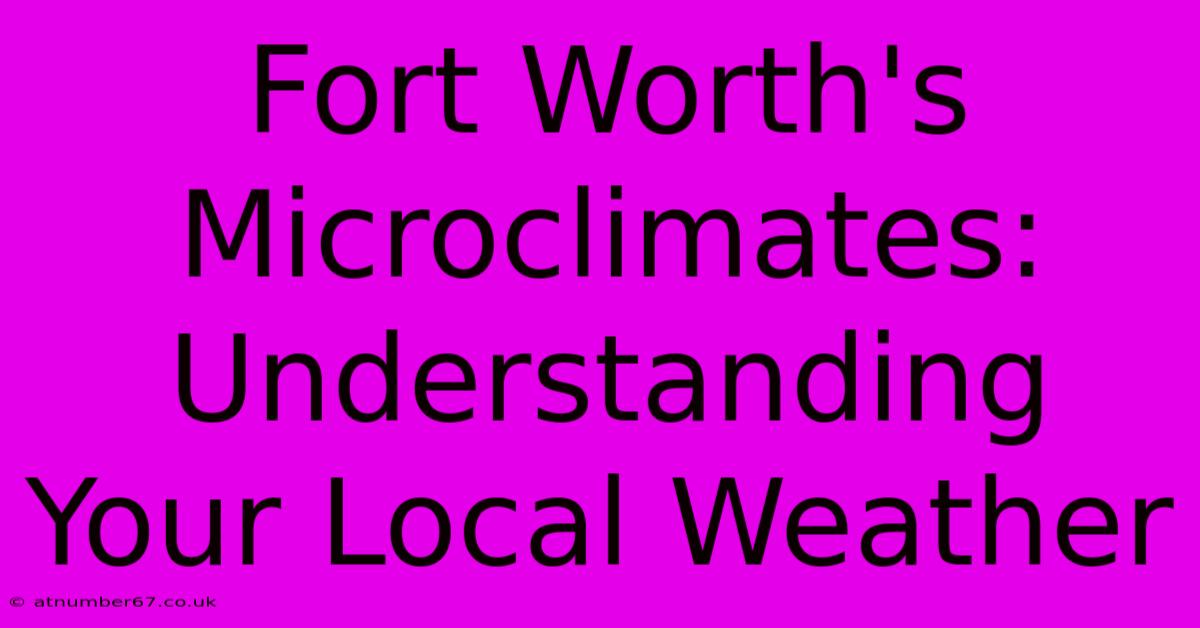Fort Worth's Microclimates: Understanding Your Local Weather

Table of Contents
Fort Worth's Microclimates: Understanding Your Local Weather
Fort Worth, Texas, boasts a diverse landscape, leading to fascinating variations in its local weather patterns. While the city generally experiences a humid subtropical climate, the presence of distinct geographical features creates microclimates – localized areas with significantly different weather conditions than the surrounding region. Understanding these microclimates can help residents better prepare for the sometimes unpredictable Fort Worth weather.
What are Microclimates?
A microclimate is a small-scale climate that differs significantly from the surrounding climate. These variations are influenced by factors such as:
- Elevation: Higher elevations tend to be cooler and experience more wind. Fort Worth's varied topography, including higher ground in the western and northern areas, contributes to this effect.
- Proximity to water: Bodies of water, like the Trinity River, moderate temperatures, leading to cooler summers and warmer winters nearby.
- Vegetation: Trees and other plants provide shade, reducing temperatures and increasing humidity. The presence of large parks and green spaces throughout Fort Worth influences local temperatures.
- Urban heat island effect: Densely built-up areas tend to retain heat, creating warmer temperatures than surrounding rural areas. This effect is particularly noticeable in downtown Fort Worth.
- Soil type and composition: Different soil types absorb and release heat at varying rates, impacting local temperatures.
Fort Worth's Distinct Microclimates
While pinpointing precise boundaries is difficult, several key areas exhibit notable microclimatic differences within Fort Worth:
1. Downtown Fort Worth: The Urban Heat Island
Downtown Fort Worth, with its concentration of buildings and concrete, experiences the strongest urban heat island effect. Temperatures here can be several degrees warmer than surrounding neighborhoods, particularly during heat waves. This also impacts air quality due to increased pollution trapping. Summer evenings in downtown can remain significantly warmer than other areas of the city.
2. The Trinity River Corridor: A Cooling Influence
The Trinity River and its surrounding green spaces create a cooler, more humid microclimate. The river moderates temperatures, offering a welcome respite from the summer heat. This area is often several degrees cooler than areas further away from the river, particularly during the hottest parts of the day. Residents living near the river can expect milder temperatures and higher humidity.
3. Western & Northern Hills: Elevated and Breezy
The higher elevations in the western and northern parts of Fort Worth experience cooler temperatures and increased wind. These areas often see stronger breezes, providing a natural cooling effect during the summer months. These areas can also experience more pronounced temperature swings throughout the day.
4. Suburban Areas: A Mix of Influences
Suburban areas exhibit a more varied microclimate, influenced by proximity to green spaces, bodies of water, and the urban heat island. The microclimate within individual neighborhoods can vary considerably depending on these factors. Careful consideration of local conditions is key when landscaping or designing outdoor spaces in suburban areas.
How to Adapt to Fort Worth's Microclimates
Understanding Fort Worth's microclimates allows for better preparation and adaptation:
- Check hyperlocal weather forecasts: Pay attention to forecasts specific to your neighborhood, rather than relying solely on city-wide predictions.
- Plant wisely: Choose plants suited to the specific microclimate of your location.
- Manage energy consumption: Be mindful of the urban heat island effect when using air conditioning.
- Outdoor activities: Consider the microclimate when planning outdoor activities, choosing cooler areas during the hottest parts of the day.
By understanding the nuances of Fort Worth's diverse microclimates, residents can better navigate the city's varied weather patterns and enjoy a more comfortable lifestyle. Awareness of these localized weather differences can improve your day-to-day experience and help prepare you for the sometimes unpredictable Texas weather.

Thank you for visiting our website wich cover about Fort Worth's Microclimates: Understanding Your Local Weather. We hope the information provided has been useful to you. Feel free to contact us if you have any questions or need further assistance. See you next time and dont miss to bookmark.
Featured Posts
-
Hysen Son A Game Changer
Apr 02, 2025
-
Jacob Wallenbergs Net Worth Fact Checked And Verified
Apr 02, 2025
-
Ayesha Howards Age The Key To Understanding Her Success
Apr 02, 2025
-
Mastering Antigens A Comprehensive Overview
Apr 02, 2025
-
Santner Age Cherishing Every Moment
Apr 02, 2025
